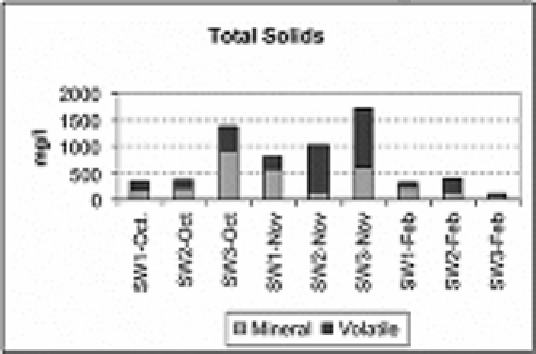Environmental Engineering Reference
In-Depth Information
enhancing erosion, which is reflected by the significant increase of TS at SW
3
during the
dry and beginning of wet seasons, as shown in Fig. 8.8.
The contribution of the farm area to SW
2
is much lower in terms of the increase of the
nutrients concentrations compared to the control point. It could be associated with the
protective function of the dike. In addition, considering the higher flow rate in the River,
the farm contribution did not cause a highly pronounced impact during the study period.
Another factor, which could explain the low nutrients' concentrations at this point, is the
better grass cover near SW
2
, leading to a higher uptake of nutrients. In addition, the
lower, unprotected part of the farm area, on the side of Marimba River, is converted to a
marsh due to the hydraulic overloading. It could be expected that this area has a
considerable nutrient uptake rate, thus preventing nutrients to reach the river water.
High rainfall figures (Fig. 8.6b) during December, January and February lead to the
dilution of the pollutants' concentrations in the wet areas and to a partial oxygenation,
thus alleviating the septic conditions and decreasing the release of P and ammonia. This
fact, together with the increased flow rates in the stream could explain the lack of impact
at SW
3
from the farm area, regarding TP and TKN during this season. Studies on
phosphorous seasonal variations in rivers mention that maximum loads are associated
with heavy rainfalls (Boar et.al. 1995, House & Denison 1998). During the period of
study, intensive
Figure 8.8. Spatial and seasonal
variations of Total Solids - mineral
and volatile fractions.
rainfalls characterize the wet season, leading to an increased turbidity, but no significant
increase in P concentrations was found at the 3 points. Actually, the TP concentrations
were reduced in November and February, while the turbidity increases, compared to the
control point. This indicates that, the most probable pathway of phosphorous transport to
the river is through direct leak from the wetland in diluted form.

